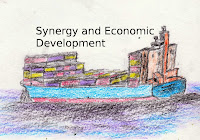Production and economic structure have a level of
association when attempting to develop stronger economic growth. According to a paper by
Tvaronaviciene & Lankauskiene (2013), a review of economic history finds that many of the main theories
associated with economic growth are about platform growth. They propose in their literary study that
economic growth often puts pressure to change the economic structure of society.
Most researchers measure economic growth through
GDP. As a benchmark, a large percentage of countries use natural resources to
create wealth. Yet this approach is not sustainable in the end. The development
of knowledge based societies and innovative sectors are more likely to maintain
growth into the future. This growth improves upon the livelihoods of those
within the workforce.
Adam Smith produced the famous book An Inquiry into the Nature and Causes of
Wealth of Nations (1776). Market forces are seen as the invisible hand and are generally better
regulators than government (Willis, 2005). Societies that seek to gain wealth
begin to improve upon their production and then export that production to other
areas of the world.
John Maynard
Keynes published the General Theory of
Employment, Interest and Money (1936). In Keynes argument, the free market could be a
positive or a negative force and that investment was the real key to overall
growth (Willis, 2005). Continually investing in newer infrastructure projects helps
adjust the structure and maintain higher levels of growth.
One method of increasing development was the
mobilization of domestic and foreign savings in order to generate sufficient investment
to accelerate economic growth (Todaro & Smith, 2011). Economies move from
subsistence agriculture, to modern urbanized centers and into more industrial
diverse manufacturing and services. In
order for an economy to develop, it must move transit from one economic
structure to a higher structural platform.
The paper discusses the movement from a primarily
agricultural society to one an urban society with products and services. It does
not really move beyond this point but does hint how social structure can
advance through advancements in technology. If we look at the pace of
technology development as seen in portable computers, social media, micro
manufacturing, etc. the next level of development is not yet clearly defined.
True sustainability is based in the high capacity development generated from
the advanced technologies of modern times. These technologies create a higher
platform where various entities can help form profound new products and
services through the contribution of interconnected societal elements.
Willis, (2005). Theories
and practices of development. Routledge, Taylor & Fracis group: London
and New York.
Todaro, M. & Smith (2011). Economic development (Eleventh edition). Pearson Education
limited: England.
Tvaronaviciene, M. & Lankauskiene, T. (2013).
The impact of production factors and economic structures on economic
development. Business Theory and
Practice, 14 (1).

